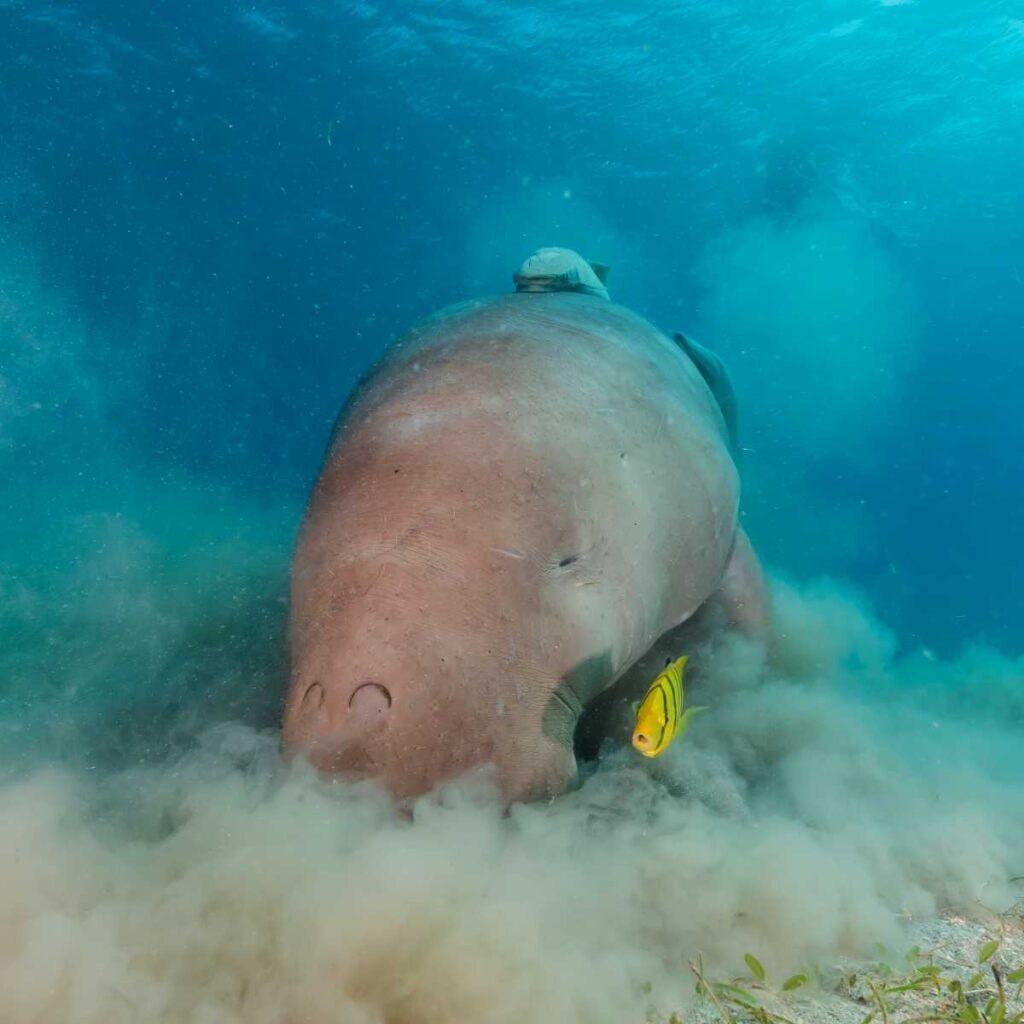Last Reviewed and Updated on February 17, 2023
Dugongs are fascinating marine mammals that have been the reason people thought there were mermaids in the sea. They inhabit coastal waters in the Indo-Pacific region, where they feed on seagrasses and algae. Learn more about these marine mammals, from the basics to some of the most interesting facts about dugongs.

About Dugongs
Dugongs (Dugong dugon) are large, herbivorous marine mammals that belong to the family Dugongidae, order Sirenia. They are found in warm coastal waters throughout the Indo-West Pacific region.
They can grow up to about 10 feet / 3 meters in length and weigh up to 880 pounds / 400 kg. Their skin is thick, and they have a broad, downward-facing snout with bristly whiskers that they use to locate and dig up seagrasses, their primary food source.
Dugongs are herbivorous and graze on seagrasses.
Dugongs are classified as vulnerable due to habitat loss and hunting.
Interesting Facts about Dugongs

1. They have a fusiform body
Like all other living sirenians (dugongs and manatees), these animals have fusiform bodies. A fusiform body means its body is shaped like a spindle with yarn spun on it.
They don’t have dorsal fins or hind limbs.
2. Dugongs have a dolphin-like tail
They are very similar to manatees, but a quick way to tell these two apart is by looking at their tail. A dugong’s tail is shaped like the tail of a dolphin, while manatees have paddle-like tails.
3. Their closest relatives are manatees and elephants
The manatees probably don’t come as a surprise as the two species look very much alike. They are more closely related to elephants than they are to any other aquatic mammals (dolphins, whales…).
4. They are nicknamed the sea cows
Dugongs are herbivores that mainly feed on seagrass. This has earned them the nickname sea cow.
5. Males have tusks
Male dugongs (and older females) grow two tusks in their upper jaw. These tusks are actually elongated incisor teeth that continue to grow throughout the dugong’s life.
The tusks of dugongs help them with feeding but don’t play a crucial role (source; Use of tusks in feeding by dugongid sirenians: observations and tests of hypotheses by D. P. Domning, B. L. Beatty).
6. You can determine the male’s age by the layers of their tusks
One way to determine the age of a male dugong is by counting the layers in its tusks (similar to tree rings in tree trunks). Dugong tusks grow throughout their life, and each year a new layer of dentine is added to the tusk.
7. They have tiny brains
Their brains account for only about 0.1% 0.4% of their body mass, meaning these animals have one of the smallest brain to body ratio in mammals (source; Encephalization Quotients and Life-History Traits in the Sirenia by T. J. O’Shea and R. L. Reep).
Their not-so-impressive brain size has nothing to do with their intellect; they are regarded as very intelligent animals with good memory.
8. They have a symbiotic relationship with remora fish
Remoras, the yellow fish that are often seen swimming near large sea animals, have a symbiotic relationship with the dugong. The fish eats the parasites that live on the skin of dugongs, and the dugongs keep the fish safe.
9. They have long lives; however, females give birth only a few times
It is estimated dugongs live for 70 years or more; however, the female gives birth only a few times during her lifetime, which isn’t often seen in nature.
10. They may be what inspired the myth of mermaids
Mermaids are believed to be inspired either by dugongs or manatees.
11. Dugongs have poor eyesight
They do have a keen sense of smell to compensate for their poor vision. They also feel their surroundings with their sensitive bristles.
